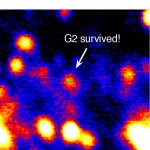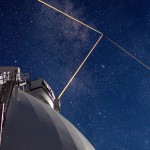With all of the emotion being expressed over telescopes on the mountain this week, just a reminder of why Mauna Kea is the perfect place from which to look to the heavens…

When you want to see the stars, find someplace dark
With all of the emotion being expressed over telescopes on the mountain this week, just a reminder of why Mauna Kea is the perfect place from which to look to the heavens…

Sometimes it takes a village to find new and unusual objects in space. Volunteers scanning tens of thousands of starry images from NASA’s Spitzer Space Telescope, using the Web-based Milky Way Project, recently stumbled upon a new class of curiosities that had gone largely unrecognized before: yellow balls. The rounded features are not actually yellow — they just appear that way in the infrared, color-assigned Spitzer images.

“With prompting by the volunteers, we analyzed the yellow balls and figured out that they are a new way to detect the early stages of massive star formation,” said Charles Kerton of Iowa State University, Ames. “The simple question of ‘Hmm, what’s that?’ led us to this discovery.” Kerton is lead author, and Wolf-Chase a co-author, of a new study on the findings in the Astrophysical Journal.
The Milky Way Project is one of many so-called citizen scientist projects making up the Zooniverse website, which relies on crowdsourcing to help process scientific data. So far, more than 70 scientific papers have resulted from volunteers using Zooniverse, four of which are tied to the Milky Way Project. In 2009, volunteers using a Zooniverse project called Galaxy Zoo began chatting about unusual objects they dubbed “green peas.” Their efforts led to the discovery of a class of compact galaxies that churned out extreme numbers of stars.
Continue reading “Citizen Scientists Lead Astronomers to Mystery Objects in Space”
W. M. Keck Observatory press release…
The mystery about a thin, bizarre object in the center of the Milky Way headed toward our galaxy’s enormous black hole has been solved by UCLA astronomers using the W. M. Keck Observatory, home of the two largest telescopes on Earth. The scientists studied the object, known as G2, during its closest approach to the black hole this summer, and found the black hole did not dine on it. The research is published today in the journal Astrophysical Journal Letters.

“G2 survived and continues happily on its orbit; a gas cloud would not do that,” said Andrea Ghez, UCLA professor of physics and astronomy who holds the Lauren B. Leichtman and Arthur E. Levine Chair in Astrophysics, and directs the UCLA Galactic Center Group. “G2 was completely unaffected by the black hole; no fireworks.”
Instead, the team has demonstrated it is a pair of binary stars that had been orbiting the black hole in tandem and merged together into an extremely large star, cloaked in gas and dust, and choreographed by the black hole’s powerful gravitational field.
“G2 is not alone,” said Ghez, who uses Keck Observatory to study thousands of stars in the neighborhood of the supermassive black hole. “We’re seeing a new class of stars near the black hole, and as a consequence of the black hole.”
Ghez and her colleagues — who include lead author Gunther Witzel, a UCLA postdoctoral scholar in Ghez’s research group, and Mark Morris, a UCLA professor of physics and astronomy — studied the event with both of the 10-meter telescopes at Keck Observatory.
Continue reading “Mysterious G2 Cloud Near Black Hole Identified”
A photograph of serendipity.
The photograph was planned… Somewhat. I knew there were some picturesque trees on the lava field along Saddle road. The plan was to shoot one of these trees silhouetted against the Milky Way and Mauna Loa. That was the plan. At least until the plan met reality.
Shot as planned the results were less than stellar. Actually they were rather boring. The rising summer Milky Way was spectacular, nothing else worked. The enormous bulk of Mauna Loa became a bump on the horizon from the low angle with the 14mm lens. The trees did not look like much against the dark.
Serendipity intervened… First a passing car lit the trees with dramatic results. Car headlights caught the trees at just the right angle to light up the right bits, a lucky bit of geometry and road alignment. Looking at the image on my screen I was intrigued… I repositioned the camera and shot again when another vehicle passed… This was working!
As I waited for other passing cars the shots deteriorated, odd glows across the frame. Were the headlights catching the big dome of glass at the front of the lens? Blocking the light from the headlights on the camera did not help. I pull out a flashlight to check the camera… Ack! The lens was fogging up!
Retrieving the anti-dew kit and a battery from the vehicle I secured a dew strap around the camera lens. At this point I wanted the shot and was willing to work for it. I was lucky again… I had thrown the dew gear in the car as a last moment afterthought.
It took time for the lens to warm and clear. As I waited dawn crept into the sky. I took a last few shots as the light increased and the stars faded. The dawn light added a nice shade of blue to the sky with a hint of peach to one side, another serendipitous bit that added to the photo. A last wisp of fog on the lens was just enough to create halos around Mars and the brighter stars.
Not a bad result! With a little skill and more than a little luck. The shot has been entered in the Hawai’i Photo Expo. Hopefully the jurors think the shot is as good as I think it is.

W. M. Keck Observatory Press Release…
Today, UCLA astronomers using the W. M. Keck Observatory reported the discovery of a remarkable star that orbits the enormous black hole at the center of our Milky Way galaxy in a blistering 11-and-a-half years, the shortest known orbit of any star near this black hole.

Before this discovery, astronomers knew of only one star near the black hole with a very short orbit: S0-2, which Ghez used to call her “favorite star” and whose orbit is 16 years. (The “S” is for Sagittarius, the constellation containing the galactic center; its name is Latin for the archer.)